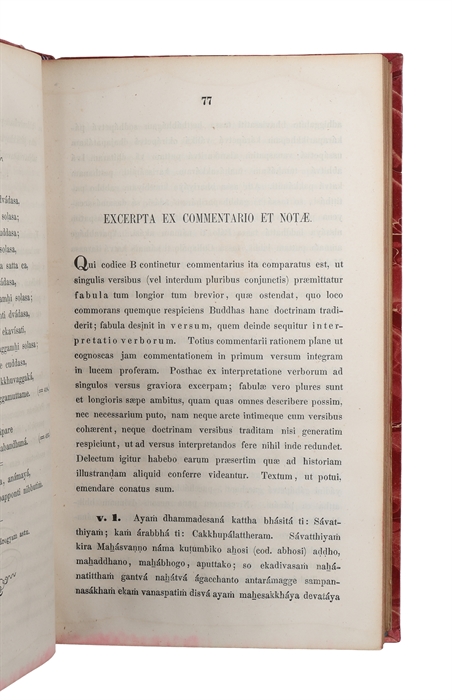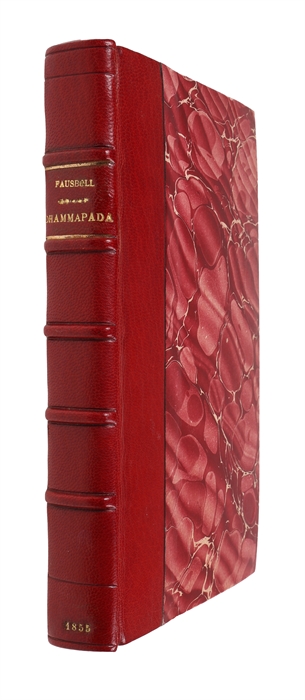FIRST FULL TRANSLATION OF THE DHAMMAPADA - FOUNDING PALI STUDIES IN THE WEST
FAUSBÖLL, V. (edt., trans. et comm.) - DHAMMAPADA
Dhammapadam. Ex tribus codicibus hauniensibus palice edidit, latine vertit, excerptis ex commentario palico notisque illustravit.
Hauniæ (i.e. Copenhagen), 1855.
8vo. Bound in a lovely recent red half morocco with five raised bands and gilt title and year to spine. Red marbled paper over boards and lovely blue marbled endpapers. All edges gilt. A damp stain throughout - to most of the leaves it it only marginal, but on the first leaves it touches the text slightly and to the last couple of quires more. Apart from that, only lighter brownspotting. One leaf (pp. 65-66 with a restored tear, affecting text, but with barely any loss of lettering (half of an L and half of an e are very vague). First leaf of text with a marginal annotation and hand pagination. (4), X, 470 pp.
Exceedingly scarce first edition of the work that founded Pali-studies in the West, the foundational first Western publication of Theravada-Buddhism, namely Fausböll’s critical edition of the Dhammapada, being the first European edition of a complete Pali-text as well as the first Latin translation of the Dhammapada, today probably the most frequently translated Buddhist text in the world. This Latin translation is also the first full non-Asian translation. Excerpts of the Dhammapada had appeared in English in the periodical The Friend printed in Colombo, Sri Lanka, but a full English translation, which is based upon Fausböll’s version, only appeared in 1870. The first German translation appeared in 1860. But none of these other earliest translations had anywhere near the impact that Fausböll’s critical edition along with the Latin translation came to have upon the study of Buddha and Buddhism in the West. With Fausböll’s publication, the Dhammapada was introduced in the West, where it came to find great dissemination and is now the most frequently translated Buddhist text in Europe. The Dhammapada, the extremely influential collection of sayings of the Buddha in verse form, constitutes one of the most widely read and best known Buddhist scriptures. The original version of the Dhammapada is in the Khuddaka Nikaya, a division of the Pali Canon of Theravada Buddhism. Each saying recorded in the collection was made on a different occasion in response to a unique situation that had arisen in the life of the Buddha and his monastic community. “The Dhammapada is the best known and most widely esteemed text in the Pali Tipitaka, the sacred scriptures of Theravada Buddhism. The work is included in the Khuddaka Nikaya ("Minor Collection") of the Sutta Pitaka, but its popularity has raised it far above the single niche it occupies in the scriptures to the ranks of a world religious classic. Composed in the ancient Pali language, this slim anthology of verses constitutes a perfect compendium of the Buddha's teaching, comprising between its covers all the essential principles elaborated at length in the forty-odd volumes of the Pali canon.” (The Dhammapada. The Buddha's Path of Wisdom. Translated from the Pali by Acharya Buddharakkhita with an Introduction by Bhikkhu Bodhi, 1996). Buddhist tradition has it that shortly after the passing away of the Lord Buddha, five hundred of his disciples met in council at Rajagaha in order to recall the truths they had received from their spiritual teacher during the previous forty-five years. They wanted these truths about moral and spiritual conduct to live on forever and for Buddha’s message to be available for all future disciples. The followers and Arhat felt the responsibility to convey the teaching and discipline of the Buddhist order as faithfully and truly as possible, and having no written texts to rely on, they prepared the many discourses for recitation with repetitions in various contexts, so that they could be remembered. Like the verses of Homer and other ancient works that were only written down later. “At that time, according to the Sinhalese, the Dhammapada was orally assembled from the sayings of Gautama given on some three hundred different occasions. Put in verse form the couplets contrast the vanity of hypocrisy, false pride, heedlessness, and selfish desire with the virtues of truthfulness, modesty, vigilance, and self-abnegation. The admonitions are age-old, yet they strike home today, their austerity of purpose fittingly relieved by gentle humor and earthy simile. Subsequently, several renditions of the Dhammapada in the Sanskrit and Chinese languages came into circulation; likewise, a number of stanzas are to be found almost verbatim in other texts of the canonical literature, testifying to the esteem in which its content was anciently held. Since first collated, the Dhammapada has become one of the best loved of Buddhist scriptures, recited daily by millions of devotees who chant its verses in Pali or in their native dialect.” (Bodhi, 1996). “The Dhammapada, an anthology of verses attributed to the Buddha, has long been recognized as one of the masterpieces of early Buddhist literature. Only more recently have scholars realized that it is also one of the early masterpieces in the Indian tradition of kavya, or belles lettres.” (The Dhammapada. A Translation. translated from the Pali by Thanissaro Bhikkhu). Viggo Fausböll (1821-1908) was a Danish educator, translator, orientalist, linguist, and most of all a pioneer of Pali scholarship. He studied at the University of Copenhagen, where he later became professor, teaching Sanskrit and Esat Indian philology. His magnum opus is his groundbreaking 1855 commented edition of the Dhammapada, with Latin translation, which founded Pali scholarship in the West and formed the basis for later translations and editions. A new edition of it appeared in 1900. Fausböll became Knight of Dannebrog in 1888, Dannebrogsmand in 1891, and Commander 2nd degree in 1898. The work is of the utmost scarcity outside of institutional holdings. We have never seen a copy in the trade before, and we have not been able to trace a single copy at auction.
Order-nr.: 62322




